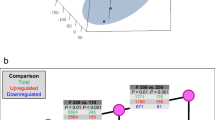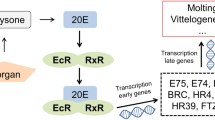Abstract
Although the past two decades have witnessed a significant increase in the number of studies investigating effects of estrogenic chemicals on amphibians, to date little is known about specific molecular interactions of estrogens with the hypothalamus–pituitary–gonadal–hepatic axis in developing amphibians. Here, tissue-specific functional sets of genes, derived previously from studies of fishes exposed to endocrine active chemicals, were evaluated in Xenopus laevis exposed to 17α-ethynylestradiol (EE2) throughout their early development. Specifically, transcriptional responses of X. laevis exposed to 0.09, 0.84, or 8.81 µg EE2/L were characterized during sexual differentiation [31 day post hatch (dph)] and after completion of metamorphosis during the juvenile stage (89 dph). While at 31 dph there were no consistent effects of EE2 on abundances of transcripts,at 89 dph X. laevis exhibited significant alterations in expression of genes involved in steroid signaling and metabolism, synthesis of cholesterol, and vitellogenesis. Specifically, expression of androgen receptor, farnesyl diphosphate synthase, estrogen receptor α, and vitellogenin A2 was significantly greater (>2-fold) than in controls while expression of farnesoid x-activated receptors α and β was significantly less (>2-fold reduction) than in controls. These results support the hypothesis that sets of genes derived from studies in teleost fish can be extrapolated for use in amphibians during the juvenile stage but not in sexually undifferentiated individuals. Furthermore, changes in abundances of transcripts of the here utilized sets of genes in animals sampled post sexual differentiation were in accordance with developmental effects and alterations of gonadal histology reported in a parallel study. This set of genes might be useful for predicting potential adverse outcomes at later life-stages.



Similar content being viewed by others
References
Ankley G, Brooks B, Huggett D, Sumpter J (2007) Repeating history: pharmaceuticals in the environment. Environ Sci Technol 41:8211–8217
Chang C, Witschi E (1955) Breeding of sex-reversed males of Xenopus laevis Daudin. Proc Soc Exper Biol Med 89:150–152
Chang H, Wan Y, Naile J, Zhang X, Wiseman S, Hecker M, Lam M, Giesy J, Jones P (2010) Simultaneous quantification of multiple classes of phenolic compounds in blood plasma by liquid chromatography-electrospray tandem mass spectrometry. J Chromatogr A 1217:506–513
Corcoran J, Winter M, Tyler C (2010) Pharmaceuticals in the aquatic environment: a critical review of the evidence for health effects in fish. Crit Rev Toxicol 40:287–304
Eick G, Thornton J (2011) Evolution of steroid receptors from an estrogen-sensitive ancestral receptor. Mol Cell Endocrinol 334:31–38
Ekman D, Teng Q, Villeneuve D, Kahl M, Jensen K, Durhan E, Ankley G, Collette T (2009) Profiling lipid metabolites yields unique information on sex- and time-dependent responses of fathead minnows (Pimephales promelas) exposed to 17 alpha-ethynylestradiol. Metabolomics 5:22–32
Gibson R, Smith M, Spary C, Tyler C, Hill E (2005) Mixtures of estrogenic contaminants in bile of fish exposed to wastewater treatment works effluents. Environ Sci Technol 39:2461–2471
Hanselman T, Graetz D, Wilkie A (2003) Manure-borne estrogens as potential environmental contaminants: a review. Environ Sci Technol 37:5471–5478
Henriquez-Hernandez L, Flores-Morales A, Santana-Farre R, Axelson M, Nilsson P, Norstedt G, Fernandez-Perez L (2007) Role of pituitary hormones on 17 alpha-ethinylestradiol-induced cholestasis in rat. J Pharm Exp Therap 320:695–705
Hogan N, Duarte P, Wade M, Lean D, Trudeau V (2008) Estrogenic exposure affects metamorphosis and alters sex ratios in the northern leopard frog (Rana pipiens): identifying critically vulnerable periods of development. Gen Comp Endocrinol 156:515–523
Jarošová B, Erseková A, Hilscherová K, Loos R, Gawlik B, Giesy JP, Bláha L (2014) Europe-wide monitoring of estrogenicity in wastewater treatment plant effluents: the need for the effect-based monitoring. Environ Sci Pollut Res. doi:10.1007/s11356-014-3056-8
Jobling S, Nolan M, Tyler C, Brighty G, Sumpter J (1998) Wide spread sexual disruption in wild fish. Environ Sci Technol 32:2498–2506
Kidd K, Blanchfield P, Mills K, Palace V, Evans R, Lazorchak J, Flick R (2007) Collapse of a fish population following exposure to a synthetic estrogen. Proc Nat Acad Sci 104:8897–8901
Kolpin D, Furlong E, Meyer M, Thurman E, Zaugg S, Barber L, Buxton H (2002a) Pharmaceuticals, hormones, and other organic wastewater contaminants in US streams, 1999–2000. Environ Sci Technol 36:1202–1211
Kolpin D, Furlong E, Meyer M, Thurman E, Zaugg S, Barber L, Buxton H (2002b) Response to comment on “Pharmaceuticals, hormones, and other organic wastewater contaminants in US streams, 1999–2000: a national reconnaissance”. Environ Sci Technol 36:4007–4008
Lutz I, Kloas W, Springer T, Holden L, Wolf J, Krueger H, Hosmer A (2008) Development, standardization, and refinement of procedures for evaluating effects of endocrine active compounds on development and sexual differentiation of Xenopus laevis. Anal Bioanal Chem 390:2031–2048
Martinez-Becerra P, Monte I, Romero M, Serrano M, Vaquero J, Macias R, Del Rio A, Grane-Boladeras N, Jimenez F, San-Martin F, Pastor-Anglada M, Marin J (2012) Up-regulation of FXR isoforms is not required for stimulation of the expression of genes involved in the lack of response of colon cancer to chemotherapy. Pharm Res 66:419–427
Miyata S, Koike S, Kubo T (1999) Hormonal sex reversal and the genetic control of sex differentiation in Xenopus. Zool Sci 16:335–340
Muthusamy S, Andersson S, Kim HJ, Butler R, Waage L, Bergerheim U, Gustafsson JA (2011) Estrogen receptor beta and 17-beta-hydroxysteroid dehydrogenase type 6, a growth regulatory pathway that is lost in prostate cancer. Poc Nat Acad Sci 108:20090–20094
Park B, Kidd K (2005) Effects of the synthetic estrogen ethinylestradiol on early life stages of mink frogs and green frogs in the wild and in situ. Environ Toxicol Chem 24:2027–2036
Pettersson I, Berg C (2007) Environmentally relevant concentrations of ethynylestradiol cause female-biased sex ratios in Xenopus tropicalis and Rana temporaria. Environ Toxicol Chem 26:1005–1009
Reschly E, Ai N, Welsh W, Ekins S, Hagey L, Krasowski M (2008) Ligand specificity and evolution of liver X receptors. J Steroid Biochem Mol Biol 110:83–94
Rivas A, Fisher J, McKinnell C, Atanassova N, Sharpe R (2002) Induction of reproductive tract developmental abnormalities in the male rate by lowering androgen production or action in combination with a low dose of diethylstilbestrol: evidence for importance of the androgen-estrogen balance. Endocrinol 143:4797–4808
Rotchell J, Ostrander G (2003) Molecular markers of endocrine disruption in aquatic organisms. J Toxicol Environ Health Part B 6:453–495
Rozen S, Skaletsky H (2000) Primer3 on the WWW for general users and for biologist programmers. In: Krawetz S, Misener S (eds) Bioinformatics methods and protocols: methods in molecular biology. Humana Press, Totowa, pp 365–386
Sharpe R, MacLatchy D (2007) Lipid dynamics in goldfish (Carassius auratus) during a period of gonadal recrudescence: effects of beta-sitosterol and 17 beta-estradiol exposure. Comp Biochem Physiol C 145:507–517
Simon P (2003) Q-Gene: processing quantitative real-time RT-PCR data. Bioinformatics 19:1439–1440
Smith D, Penning T, Ansari A, Munday K, Akhtar M (1978) Oestrogen-induced cholesterol and fatty acid biosynthesis in Xenopus laevis liver during vitellogenic response. Biochem J 174:353–361
Tata J, Baker B, Machuca I, Rabelo E, Yamauchi K (1993) Autoinduction of nuclear receptor genes and its significance. J Steroid Biochem Mol Biol 46:105–119
Tompsett A, Wiseman S, Higley E, Pryce S, Chang H, Giesy J, Hecker M (2012) Effects of 17-alpha-ethynylestradiol on sexual differentiation and development of the African clawed frog (Xenopus laevis). Com Biochem Physiol C 156:202–210
Tompsett A, Wiseman S, Higley E, Giesy J, Hecker M (2013a) Effects of exposure to 17alpha-ethynylestradiol during larval development on growth, sexual differentiation, and abundances of transcripts in the liver of the wood frog (Lithobates sylvaticus). Aquat Toxicol 126:42–51
Tompsett A, Wiseman S, Higley E, Giesy J, Hecker M (2013b) Effects of exposure to 17alpha-ethynylestradiol during sexual differentiation on the transcriptome of the African clawed frog (Xenopus laevis). Environ Sci Technol 47:4822–4828
Villalpando I, Merchant-Larios H (1990) Determination of the sensitive stages for gonadal sex-reversal in Xenopus laevis tadpoles. Int J Develop Biol 34:281–285
Villeneuve D, Garcia-Reyero N, Martinovic-Weigelt D, Li Z, Watanabe K, Orlando E, LaLone C, Edwards S, Burgoon L, Denslow N, Perkins E, Ankley G (2012) A graphical systems model and tissue-specific functional sets of genes to aid transcriptomic analysis of chemical impacts on the female teleost reproductive axis. Mut Res 746:151–162
Watanabe K, Li Z, Kroll K, Villeneuve D, Garcia-Reyero N, Orlando E, Sepulveda M, Collette T, Ekman D, Ankley G, Denslow N (2009) A computational model of the hypothalamic-pituitary-gonadal axis in male fathead minnows exposed to 17alpha-ethinylestradiol and 17beta-estradiol. Toxicol Sci 109:180–192
Witschi E, Foote C, Chang C (1958) Modification of sex differentiation by steroid hormones in a tree frog (Pseudacris nigrita triseriata Wied). Proc Soc Exp Biol Med 97:196–197
Yoshimoto S, Okada E, Umemoto H, Tamura K, Uno Y, Nishida-Umehara C, Matsuda Y, Takamatsu N, Shiba T, Ito M (2008) A W-linked DM-domain gene, DM-W, participates in primary ovary development in Xenopus laevis. PNAS 105:2469–2474
Zollner G, Trauner M (2009) Nuclear receptors as therapeutic targets in cholestatic liver diseases. Br J Pharmacol 156:7–27
Acknowledgments
The authors wish to acknowledge the support by the Natural Science and Engineering Research Council of Canada (Discovery Grants), Grants from Western Economic Diversification Canada (Project # 6578 and 6807), and an instrumentation Grant from the Canada Foundation for Innovation to J. Giesy and M. Hecker. J. Giesy and M. Hecker were supported by the Canada Research Chair program. Furthermore, John Giesy was supported by Distinguished visiting Professorship in the Department of Biology and Chemistry and State Key Laboratory in Marine Pollution, City University of Hong Kong, the 2012 “High Level Foreign Experts” (#GDW20123200120) program, funded by the State Administration of Foreign Experts Affairs, the P.R. China to Nanjing University and the Einstein Professor Program of the Chinese Academy of Sciences. The authors would like to thank J. Doering, S. Beitel, B. Tendler, and T. Tse for their assistance.
Conflict of interest
The authors declare no conflict of interest in context with the presented work.
Author information
Authors and Affiliations
Corresponding author
Rights and permissions
About this article
Cite this article
Tompsett, A.R., Higley, E., Pryce, S. et al. Transcriptional changes in African clawed frogs (Xenopus laevis) exposed to 17α-ethynylestradiol during early development. Ecotoxicology 24, 321–329 (2015). https://doi.org/10.1007/s10646-014-1380-x
Accepted:
Published:
Issue Date:
DOI: https://doi.org/10.1007/s10646-014-1380-x




